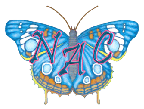Volume 6 Issue 4

SPATTERWARE

First, there are two types of pottery that are often confused; spongeware and spatterware. They are quite different. Spatterware was first produced in England in the late 1700's. Spatterware took quite
abit more time to produce. It was used on cups, saucers, plates, and coffeepots. Some pieces were decorated with hand-painted designs in the center. Some of the designs were named "Peafowl, Schoolhouse,
or Tulip.
Spongeware was a less expensive, less time-intensive way of decoration. It was produced by daubing color on with a cut sponge, brush or cloth. The most popular type of spongeware is the white with blue.
It is two-three times more expensive than the green or brown. Those with three colors are also more expensive. The blue and white spongeware is still being produced today.
Spatterware was first produced by the well-known Wedgwood Company. It was one of the most popular exports to the U. S. by Wedgwood. Later, American china companies began imitating the process
on a large scale. There are some companies that are still producing the spatterware today. Spatterware was developed by Wedgwood from the glazing of cream earthenware. It involves spattering the piece
with hundreds of small dots. Each dot is tediously handpainted with a paintbrush forming a pattern or border to the china. It looks similar to the spongeware effect.
The most collectibles spatterware was produced in the United States from around 1850. Some pieces sell for as much as $400-$500 and some, such as an Adam Rose plate, tureen, or lidded bowl in three colors
can sell for $1000+ at auction.
Makers' marks of spatterware that have been recorded include Adams & Co. and William Adams, Davenport, Harvey, Mayer, William Ridgway & Co., Phillips, Podmore & Walker, E. T. Troutbeck, Barlow,
Harvey and Cotton, Thomas Walker, and Enoch Wood.
There is a vast display of approximately 1200 pieces of spatterware in the "Spatterware Hall" at Winterthur Museum in Delaware. To view some examples of spatterware:
Benjamin Courtney Antiques
RESOURCES:
Collector Cafe-Spatterware
Spatterware by M.S. Cooperson of "Embellish"
Spatterware and Spongeware
Warman's Antiques and Collectibles Price Guide - 32nd Edition
Schroeder's Antiques Price Guide-18th edition
**************************************************************
The Next Monthly Newsletter will feature the history of pewter.
SPATTERWARE
![]()
Questions? Email Us!
SIGN UP HERE!
Get on our FREE Newsletter
Mailing List!

![]()

ACCEPTED!
Credit Card Payment Processing
 |

